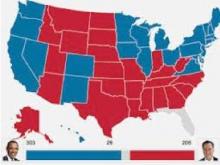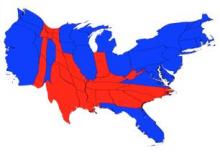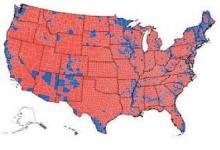The Disenfranchisement of Rural America
By: James HuffmanPosted on March 13, 2013 Defining Ideas: A Hoover Institution Journal Topics:
Anyone who pays even passing attention to American politics is familiar with the map (Figure 1) of the United States showing states in which a majority of voters favored President Obama (colored blue) and those where Romney garnered the most votes (in red). This map conveys three dominant messages: first, that states can be meaningfully described as either red or blue; second, that the West Coast, the upper Midwest, and the Northeast are solidly blue, and the rest of the country is mostly red; and third, that, geographically speaking, more of the country is red than blue.
Figure 1
Those concerned about how Romney lost in what appears to be a mostly red country should refer themselves to Figure 2, in which the states are distorted to reflect their populations. More populous states have more votes in the Electoral College than do sparsely populated states.
Figure 2
But a third map (Figure 3) showing the nation’s 3,035 counties in the same color scheme reveals that portraying states as either blue or red obscures much of what we might want to know about the states and the voters who inhabit them. On this map, we see that most of the blue states are in fact mostly red. The reality of vast expanses of red in some of the bluest of states should concern us if we truly care about self-governance.
Figure 3
The Fate of Self-Governance
With each passing election, rural and small town Americans have ever less influence on their state and national governments and ever declining control over the governance of their own communities. Their lives are increasingly controlled from distant state capitals and from the even more distant Washington, D.C., by politicians with little incentive to pay attention to their country cousins. To some extent, their disenfranchisement is the inevitable result of a century of urbanization and economic centralization. But the erosion of self-governance in rural America is also the result of a generally well intentioned but simplistic understanding of democracy and the associated elimination of institutional protections of local democratic governance.
Two ideas have been central to this effective disenfranchisement of rural America. First, that one person/one vote is an inviolable principle of democratic government under the United States Constitution. Second, that the winners of elections owe allegiance only to those who voted for them, no matter how close the margin of victory.
Consider the claim made by supporters of President Obama’s call for higher taxes on the wealthy in response to those wishing to preserve all of the tax rates enacted under President Bush. “The people have spoken. We won the election. You lost. Case closed.” Had Mitt Romney won the election, Republicans would have offered a similar response to opponents of spending cuts and entitlement reform.
For some, this glib argument is like spiking the ball in the end zone—an ill-mannered, in-your-face celebration of points scored in an ongoing contest. Notwithstanding the sometimes wildly fluctuating views of the electorate, as evidenced by pre- and post-election polls, elections have increasingly come to justify claims of total victory for the winner. The winner sees no need for compromise, making it the loser’s role to obstruct such triumphalism in every way possible, and hope to prevail in the next election. Little wonder that bipartisan solutions have become elusive, and that those willing to compromise are condemned by their partisan peers as unprincipled, and unworthy of public office.
Of course, anyone with even a cursory understanding of American politics understands that elections seldom, if ever, settle matters in dispute. What we learn when the people speak at the ballot box is that the electorate is often narrowly divided on the candidates and issues. President Obama’s 51.4 percent of the popular vote is considered a convincing victory. But the fact is that 48.6 percent of the voters (59,134,475 individuals) preferred someone else.
In the democratic selection of public officials, there is no practical alternative to election by simple majority, or even by plurality. Someone must fill each office, and that cannot be accomplished reliably with supermajority requirements. Representative bodies can, and occasionally do, require a supermajority for enactment of legislation. But, as a general rule, little is accomplished if more than a simple majority is required. (Witness the United States Senate, where the filibuster, as now employed, effectively requires a 3/5 supermajority and little is accomplished.)
Constitutional Controls on the Tyranny of the Majority
As political scientist Martin Diamond once observed, democracy is the least worst form of government yet designed by man. The designers of America’s democratic republic well understood the shortcomings of direct democracy, notably the risk of majoritarian tyranny. Among their constitutional protections against the tyranny of the majority was the creation of a federal system that recognized multiple majorities as legitimate law makers, majorities that would also moderate the selection of the president and the enactment of laws by Congress.
In the enactment of national laws, the moderating influence of different majorities in each of the fifty states is most apparent and effective in the Senate, where each state has equal representation without regard to population. It is possible for the Senate to approve (or effectively veto) legislation with the votes of senators representing barely 17 percent of the national population (or less than 11 percent under current filibuster rules). Of course, it is rare that all 50 senators from the 25 least populous states would agree, but it is not unusual that senators representing well less than half the population determine the outcome of legislative proposals.
Although most Americans seem to accept the significant deviation from majority rule represented by the Senate, many are less tolerant of the far less counter-majoritarian system for electing the president. With each presidential election comes hand-wringing over the possibility that the candidate who loses the popular vote might prevail in the Electoral College and become president. For Americans imbued in the one person/one vote principle on which the United States Supreme Court based its mandates for state legislative reapportionment a half century ago, the prospect of this outcome is unacceptable. It is long past time, they argue, to abandon the antiquated Electoral College in favor of direct election of the president.
Defenders of the Electoral College are then quick to point out that the system designed by the framers is the product of a compromise among large and small, agricultural and commercial, northern and southern states as diverse in their regional and local communities as in the individuals making up those communities. It is, after all, a federal government for which we are electing a president. As with the Senate, the Electoral College relies on majority rule, but of a kind suited to a diverse nation. In the words of George Will, the framers designed a system “suited to moderate, consensual governance of a heterogeneous, continental nation with myriad regional and other diversities.”
This quadrennial debate over the Electoral College no doubt will continue as long as the constitution and its system for electing a president survive, but there is a related, though long dead, debate that should be revived if the interests of a significant minority of American citizens are to have ongoing influence in our democratic republic. That debate relates to the political standing of rural communities in virtually every state of the union.
The Loss of Rural Representation in State Legislatures
The reality is that rural communities have experienced a declining influence on state governance ever since reapportionment was first mandated in the 1960s. Many will say that this is as it should be. Rural and small town voters constitute minorities in every state, and minorities are supposed to lose in a democracy. But that is the same argument made against the Electoral College, given the possibility that a candidate who wins the popular vote might lose in the Electoral College, and it is an argument that also would condemn the much greater counter-majoritarian nature of the U.S. Senate.
Different and diverse majorities in each state are combined in the U.S. Senate to pursue national policies that are truly national and not just what will serve the interests of the nine states in which the majority of the nation’s population resides. There is no similar safeguard at the state level for different and diverse majorities in small town and rural communities that happen to constitute the red regions of the blue states—though there once was.
Prior to the 1964 United States Supreme Court decision in Reynolds v. Sims, most state legislatures included one house apportioned on the basis of population and a second chamber apportioned on the basis of counties or other geographical regions. Many of the former had not been reapportioned for decades, leaving growing urban areas with less representation per capita than rural regions. On the basis of the principle of one person/one vote, the Court found that the failure of most states to regularly reapportion their lower houses put them in violation of the equal protection clause of the 14th amendment.
While one person/one vote was widely accepted as the appropriate standard for lower state legislative chambers, most states defended their geographically apportioned upper houses by drawing a parallel to the U.S. Congress in which the Senate is apportioned on the basis of states rather than population. The Supreme Court rejected their argument, concluding that counties and other local entities are merely subdivisions of unitary state governments lacking any claim comparable to state sovereignty. “Legislators,” said the Court, “represent people, not trees or acres. Legislators are elected by voters, not farms or cities or economic interests”
The Revival of Rural Communities
On the technical question of what constitutes a sovereign entity, the Court was right. But history has shown that the Court was wrong in its understanding of the function served by geographically apportioned state senates. While state senators elected from geographic regions rather than on the basis of population certainly did not represent trees or acres, they did represent communities.
Of course, reapportionment of the upper houses of state legislatures on the basis of population did not eliminate county and town governments, but as state legislatures became increasingly homogenous and urban-centric, states gradually intervened in more and more matters that were once of purely local concern. Inexorably, the values and ambitions of urban America have been imposed on small town and rural communities. Despite the often broad agreement among their citizens, the rural communities of red county America have gradually lost control of their own destinies at the hands of statewide majorities marching to a different drummer. In many states, rural areas have become playgrounds, refuse dumps and planning laboratories for urbanites at the expense of viable and prosperous local communities.
The point is not that the different drummer is blue and the rural communities are red. That is just the reality of 21st century American politics. The point is that, because of their minority status in statewide population terms and their lack of representation as communities, rural Americans are denied full self-governance. They have become the objects of what might be called the soft tyranny of others desires and expectations.
The county by county map of the 2012 presidential election clearly portrays the irony and unfairness of a nation of predominantly red communities governed by a blue, urban, national majority. President Obama won 52 percent of the states and 51.4 percent of the popular vote, but only 20 percent of the counties. Yet, everyone in every one of those counties is subject to the will of distant majorities lacking any understanding of or stake in the local communities they control. It wasn’t supposed to be that way, and should not be that way, in our extended national republic.
Democratic government at its best must be about more than the arithmetic of nose counting. Communities require representation if they are to survive in an ever more centralized world. Not the political interest groups we now call communities, but the real communities in which people raise their children, pursue their livelihoods, and nourish their friendships. These are the communities people call home, and they are slowly decaying with the loss of control over their own destinies.
As appealing and self-evident as it seemed at the time, one person/one vote was too simple to be right for a vast and diverse republic. The U.S. Senate will survive unless we are persuaded to abandon the Constitution. Sooner or later, the Electoral College will probably give way to a national popular vote for president. But rural America was set on a path of inexorable decline a half century ago when the Supreme Court rejected the plea of rural communities for representation as communities in our extended republic. Those communities are the red counties of blue America.




